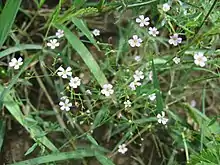Psammophiliella
Psammophiliella is a genus of flowering plants in the family Caryophyllaceae. It has only one species, Psammophiliella muralis (synonym Gypsophila muralis),[1] known as annual gypsophila, cushion baby's-breath and low baby's-breath, an annual plant principally native to Europe except the British Isles. It can be also found in Central Asia, Turkey, the Caucasus, and Siberia.
| Annual gypsophila | |
|---|---|
 | |
| Scientific classification | |
| Kingdom: | Plantae |
| Clade: | Tracheophytes |
| Clade: | Angiosperms |
| Clade: | Eudicots |
| Order: | Caryophyllales |
| Family: | Caryophyllaceae |
| Genus: | Psammophiliella Ikonn.[1] |
| Species: | P. muralis |
| Binomial name | |
| Psammophiliella muralis | |
| Synonyms[2] | |
| |
Description
Psammophiliella muralis is an annual,[3] with erect glabrous (non hairy) stems. It grows up to 30–40 cm (12–16 in) tall, with linear shaped leaves. It blooms between summer and fall, with pink or very occasionally white flowers, which are 3.5–6 cm (1.4–2.4 in) across. Later it has fruit capsules, which are ovoid or ellipsoid,[4] inside are snail-shaped seeds.[3]
Taxonomy
_(6424997729).jpg.webp)
The species was first described by the Swedish botanist Carl Linnaeus in Species Plantarum on page 408 in 1753, as Gypsophila muralis.[5][6]
It was once confused with Petrorhagia saxifraga (L) Link.[3]
The Latin specific epithet muralis is derived from the Latin word meaning 'growing on the wall'.[7]
It has the common names of 'annual gypsophila',[8] 'cushion baby's-breath', 'low baby's-breath'.[4][9]
Distribution and habitat
It is native to temperate regions of Europe and Asia, and tropical Pakistan.[10]
Range
It is found in Asia, within Kazakhstan, Uzbekistan, Siberia and Pakistan. In eastern Europe, it is found within Belarus, Estonia, Latvia, Lithuania and Ukraine. In middle Europe, it is in Austria, Belgium, the Czech Republic, Germany, Hungary, the Netherlands, Poland, Slovakia and Switzerland. In northern Europe, in Finland and Sweden. In southeastern Europe, within Bosnia and Herzegovina, Bulgaria, Croatia, Greece, Italy, North Macedonia, Romania, Serbia, Slovenia and Turkey. Lastly, it is found in southwestern Europe, it is found in France and Spain.[10]
It has naturalized in many parts of Asia, including China and Japan, as well as parts of North America, from Canada (Ontario and Quebec) and in the United States (within Connecticut, District of Columbia, Indiana, Maine, Massachusetts, Michigan, New Hampshire, New Jersey, New York, Pennsylvania, Rhode Island, South Dakota, Vermont and Wisconsin).[10]
Habitat
Grows on non-calcerous soils in eastern North America.[3]
| Wikimedia Commons has media related to Psammophiliella muralis. |
References
- "Psammophiliella Ikonn". Plants of the World Online. Royal Botanic Gardens, Kew. Retrieved 2020-02-09.
- "Psammophiliella muralis (L.) Ikonn". Plants of the World Online. Royal Botanic Gardens, Kew. Retrieved 2020-02-09.
- Flora of North America Editorial Committee (editors)Flora of North America: Magnoliophyta: Caryophyllidae, part 2, p. 155, at Google Books
- "FNA Vol. 5". efloras.org. Retrieved 12 November 2017.
- "Gypsophila muralis L. is an accepted name". theplantlist.org. 23 March 2012. Retrieved 12 November 2017.
- "Caryophyllaceae Gypsophila muralis L." ipni.org. Retrieved 12 November 2017.
- Archibald William Smith A Gardener's Handbook of Plant Names: Their Meanings and Origins, p. 160, at Google Books
- "BSBI List 2007". Botanical Society of Britain and Ireland. Archived from the original (xls) on 2015-01-25. Retrieved 2014-10-17.
- "low baby's-breath". invasiveplantatlas.org. Retrieved 12 November 2017.
- "Taxon: Gypsophila muralis L." ars-grin.gov. Retrieved 13 November 2017.